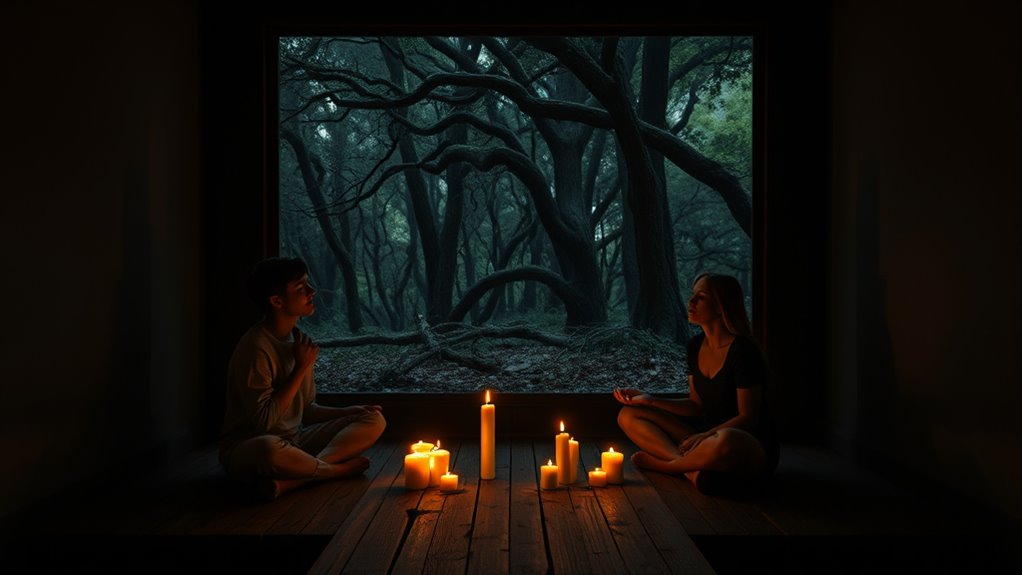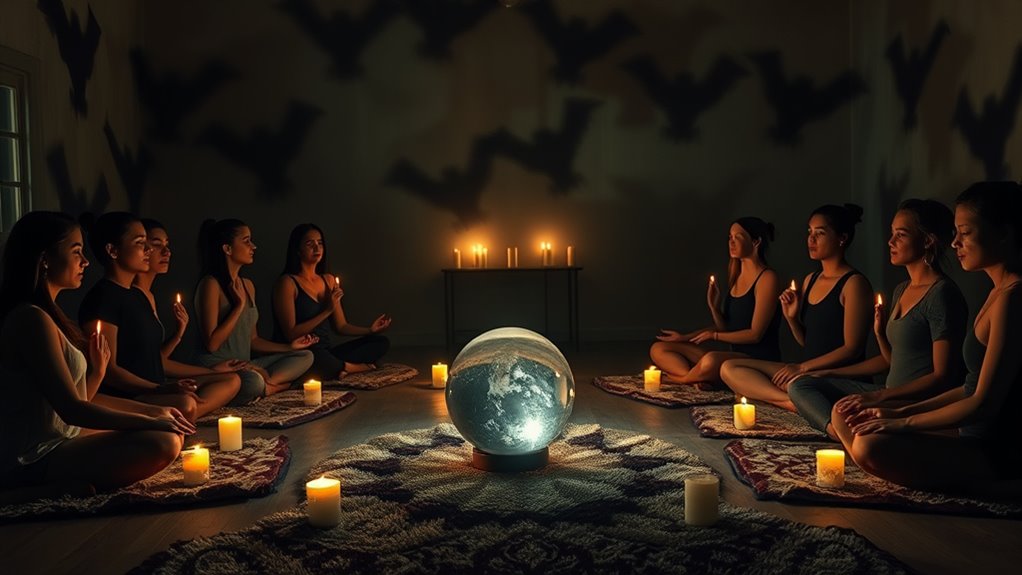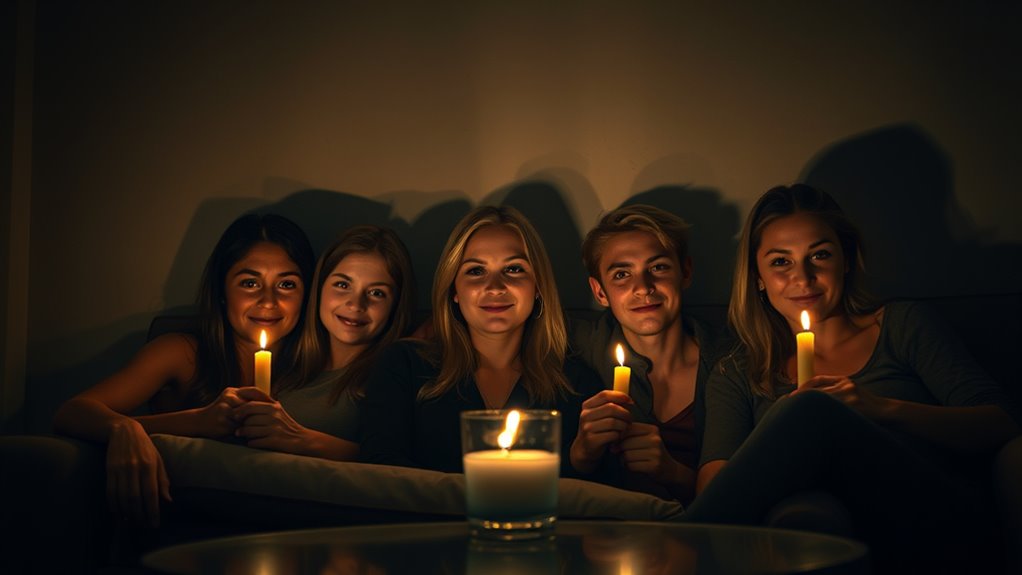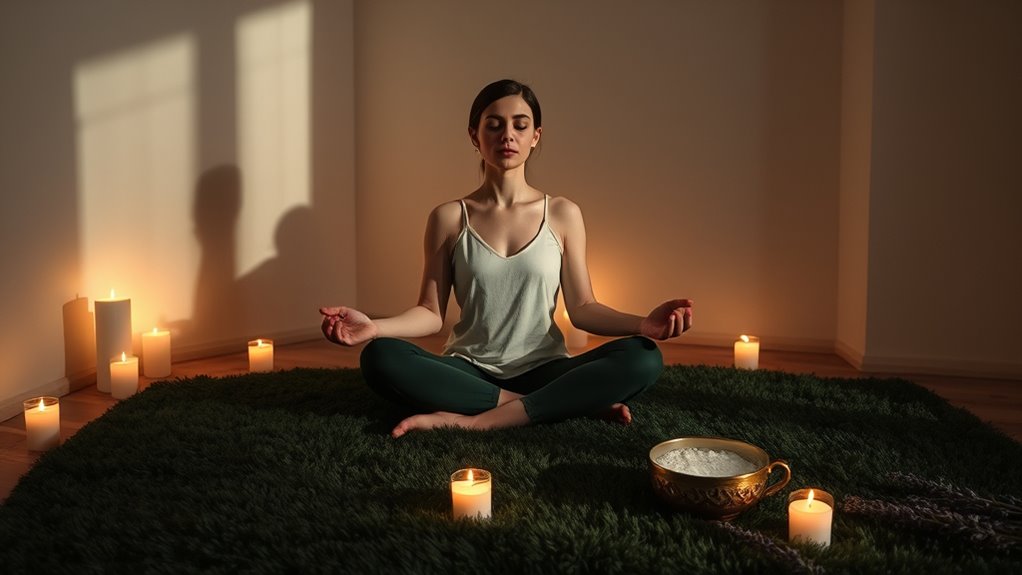To stay calm during a haunting, focus on understanding your environment and its impact on your emotions. Use techniques like deep breathing and mindfulness to regulate your feelings. Address any fears through cognitive behavioral approaches, while grounding yourself in the present. Engaging with supportive friends can also help ease anxiety. Remember, managing your stress and reactions effectively can transform your experience. You’ll find even more helpful strategies and insights ahead.
Key Takeaways
- Practice mindfulness and focus on your breath to stay present and reduce anxiety during unsettling experiences.
- Use grounding techniques, like the 5-4-3-2-1 method, to connect with your surroundings and alleviate fear.
- Engage in physical activities to release pent-up stress and improve your mood during haunting situations.
- Communicate openly with others about your feelings to foster support and reduce misunderstandings in stressful environments.
- Maintain a balanced routine with adequate sleep and nutrition to enhance your overall emotional resilience during challenging experiences.
Understanding the Environment

When you step into a space believed to be haunted, it’s essential to understand how the environment influences your perceptions.
Embedded cues, like the structure and layout of the area, can evoke feelings of unease. Lighting levels play a significant role, as shadows can distort your sense of reality. You might notice unusual odors, like sulfur, that heighten your anxiety.
Sudden temperature changes can also create discomfort, making you feel a chilling presence. Additionally, infrasound—low-frequency sounds you can’t consciously hear—can generate an unsettling atmosphere.
All these elements combine to shape your experience, often leading you to interpret common environmental disturbances as paranormal phenomena. Awareness of these factors can help you stay grounded amidst the eerie sensations.
Emotional Regulation Techniques

Although traversing a haunted environment can stir up intense emotions, employing emotional regulation techniques can help you maintain your composure.
Start by practicing mindfulness; focus on your breathing and stay present, which helps you recognize and label your feelings. Pay attention to your body’s physical sensations, as they can offer insight into your emotional state.
Identify triggers that provoke anxiety, allowing you to anticipate your reactions. Use cognitive reappraisal to shift your perspective on frightening experiences, reducing their emotional intensity.
Engage in deep breathing or physical activity to calm your mind and body. Finally, accept your emotions instead of suppressing them; acknowledgment can lead to better emotional management during stressful encounters.
Psychological Approaches to Fear

Understanding the psychological approaches to fear is essential for managing and overcoming it effectively. Fear often originates from past experiences, unresolved conflicts, or unconscious memories that shape your responses. By exploring these roots through psychodynamic therapy, you can uncover hidden issues contributing to your fears. Cognitive Behavioral Therapy (CBT) allows you to identify and challenge irrational beliefs, helping you reshape your thinking. Engaging in mindfulness practices can further enhance self-awareness and promote a calm response to fear.
Techniques like exposure therapy gradually desensitize you to your fears, while mindfulness-based therapies encourage acceptance of your thoughts. Additionally, recognizing cognitive biases can prevent distorted perceptions that amplify fear. Furthermore, understanding narcissistic behavior may provide insight into emotional manipulation that contributes to fear in relationships.
Behavioral Techniques for Calmness

To stay calm during haunting experiences, employing effective behavioral techniques can make a significant difference.
Start with deep breathing methods like the 4-7-8 technique, inhaling for four seconds, holding for seven, and exhaling for eight. Ground yourself using the 5-4-3-2-1 method, focusing on your senses to connect with your surroundings. Incorporating hydration is essential, as it aids in maintaining optimal brain function during stressful moments. Keeping the air clean with air purifiers can also enhance your environment, reducing allergens and promoting a sense of calm.
Light exercise, stretching, or yoga can alleviate tension and promote relaxation, as regular physical activity is known to boost energy levels and reduce stress. Incorporate cognitive strategies such as mindfulness to keep you present and challenge negative thoughts. Mindfulness practices can help enhance your ability to manage anxiety effectively.
Don’t underestimate the power of social support; connect with friends or join a peer support group. These techniques help you manage anxiety, stay focused, and face haunting situations with a more composed mindset. Additionally, exploring intelligent tutoring systems can provide tailored approaches to enhance your coping strategies.
Environmental Considerations for a Better Experience

Creating a calming environment can considerably enhance your experience during haunting situations. Pay attention to embedded cues in your surroundings; these physical elements can influence your perceptions.
Control the lighting levels—dim or unusual lighting can induce fear, while softer, warm tones create comfort. Guarantee good air quality; poor ventilation can lead to discomfort and heighten anxiety. Consider using an air purifier to ensure optimal air quality, as it can reduce allergens and improve respiratory health.
Also, be mindful of temperature fluctuations, as they can impact your feelings of unease. Finally, consider infrasound, which may subtly alter your emotional state.
Long-Term Stress Management Strategies

A peaceful environment sets the stage for managing stress, especially during unsettling experiences. To build long-term resilience, incorporate mindfulness practices like meditation and yoga into your routine. These techniques help you focus on the present moment, reducing worry. Regular exercise releases endorphins, boosting your mood, while a balanced diet, including high-protein breakfasts, supports mental health. Prioritize adequate sleep and stay hydrated to enhance your overall well-being. Explore emotional regulation techniques such as deep breathing and creative expression to process feelings effectively. Additionally, acknowledging feelings during stressful times can facilitate emotional recovery. Practice time management to balance work and leisure, and challenge yourself with achievable goals. By adopting these strategies, you can create a more stable foundation for handling stress, particularly during haunting situations.
The Power of Social Support

Social support can be a game changer when managing stress, especially during haunting experiences. Having a network of friends or family allows you to share your feelings, which helps you view stressful situations as more manageable. When you connect with others, your body releases oxytocin, promoting a calming effect that lowers cortisol levels and reduces anxiety. This social interaction can buffer your perceived stress, enhancing your coping mechanisms and resilience. Additionally, the emotional distress caused by parental infidelity can further underscore the importance of maintaining supportive relationships during challenging times. Engaging with supportive people not only fosters healthier lifestyle choices but also lowers your risk of stress-related health issues. Furthermore, the presence of emotional disconnection in stressful situations can be mitigated by having a reliable support system. By creating a strong support system, you can effectively navigate the challenges of a haunting and maintain your mental well-being. Additionally, open communication within your support network can facilitate deeper emotional connections, enhancing your overall resilience. The ability to share experiences with others can help address trust issues that may arise in difficult times.
Frequently Asked Questions
What Should I Wear to a Haunted House for Comfort?
When you’re heading to a haunted house, comfort is key.
Opt for dark-colored, loose-fitting clothing that allows you to blend in and move freely. Choose closed-toe shoes with good grip to keep you safe while walking.
Layer your outfit to adjust to changing temperatures. Keep accessories minimal to avoid distractions, and consider wearing something themed to fully immerse yourself in the experience.
How Can I Prepare My Kids for a Haunted House Visit?
To prepare your kids for a haunted house visit, start by evaluating their comfort levels and discussing what to expect.
Set clear boundaries and review the attraction’s details to guarantee it’s appropriate for their age.
Teach coping strategies like deep breathing and encourage open communication about their feelings.
Focus on the fun aspects to build excitement, and consider visiting during less crowded times for a more enjoyable experience.
Are There Any Haunted Houses Specifically Designed for Anxiety Sufferers?
Yes, there are haunted houses specifically designed for anxiety sufferers.
These attractions offer controlled environments, gradual exposure to fears, and trained staff ready to assist. You’ll find features like accessibility options, allowing everyone to enjoy the experience.
Imagine stepping into a space that eases your worries, where you can confront fears safely and bond with others.
With post-event relaxation areas, you can unwind and reflect, making the scary fun beneficial for your mental health.
How Do I Know if I’M Ready to Face a Haunted House?
To know if you’re ready to face a haunted house, assess your emotional stability and ability to handle sudden frights.
Familiarize yourself with the layout to avoid disorientation, and consider if you have supportive friends with you.
Also, check your physical and mental health to guarantee you’re feeling stable.
Finally, shift your mindset to view fear as part of the fun, which can enhance your overall experience.
What Common Fears Do People Have About Haunted Houses?
Ever wondered what makes haunted houses so terrifying? Common fears include claustrophobia, which grips you in tight spaces, and acrophobia, as you navigate high platforms.
You might even feel a chill from arachnophobia with creepy spiders lurking around. Nyctophobia might hit hard in the dark, leaving you anxious.
These primal fears tap into your instincts, triggering intense emotional responses that make the experience both thrilling and unnerving.
Are you ready to confront these fears?
Conclusion
In the face of a haunting, staying calm is essential. Did you know that studies show 75% of people experience heightened anxiety in spooky environments? By understanding your surroundings and employing emotional regulation techniques, you can manage your fear effectively. Remember, it’s not just about facing the unknown; it’s about using the right tools to navigate it. Surrounding yourself with supportive friends can make all the difference, turning a frightening experience into one of resilience and strength.









